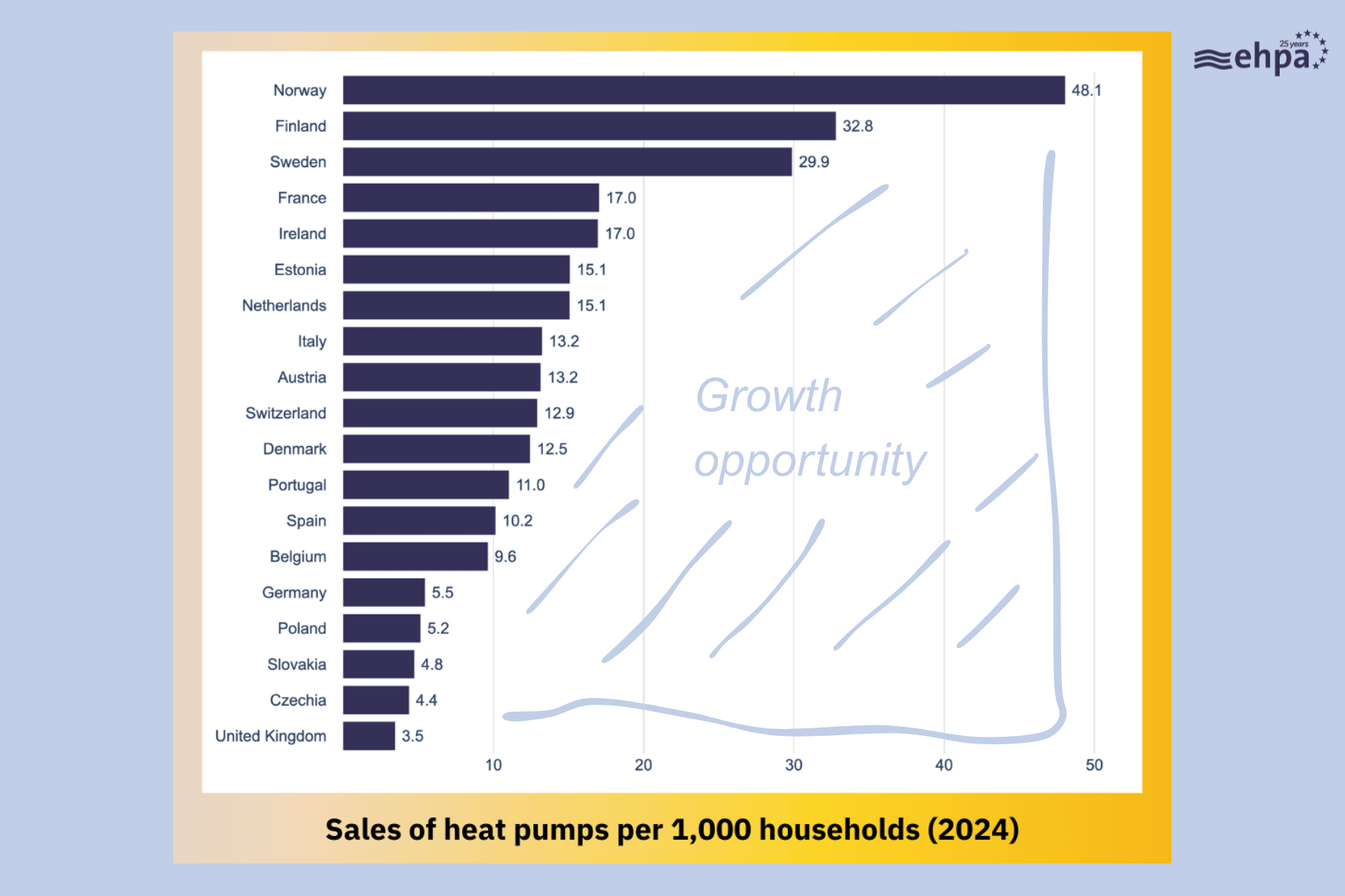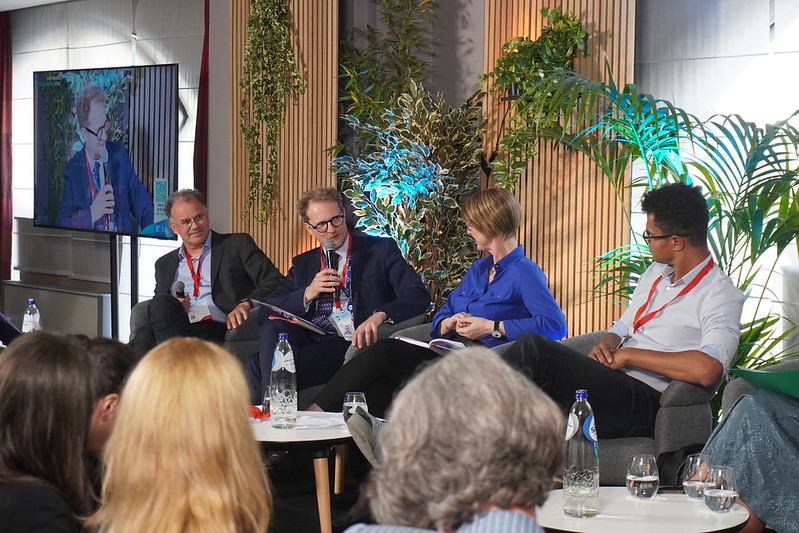
Frequently asked questions – heat pumps
Everything you wanted to know and never dared to ask:
A heat pump is a device that can provide heating, cooling and hot water for residential, commercial and industrial use.
Heat pumps take energy from the air, ground and water and turn it into heat or cool air.
Heat pumps are very energy efficient, and a sustainable way of heating or cooling buildings.
Heat pumps are very reliable.
Plus, according to the International Energy Agency, they are three to five times more efficient than gas boilers. Around 20 million heat pumps are now used in Europe, and more will be installed to reach carbon neutrality by 2050.
From the smallest units to large industrial installations, heat pumps operate through a refrigerant cycle which allows to capture and transfer energy from air, water and ground to provide heating, cooling and hot water. Due to its cyclical nature, this process can be repeated over and over again.
This is not a new discovery – yhe principle underlying the way heat pumps work goes back to the 1850s. Various forms of heat pumps have been operating for decades.
Heat pumps take most of the energy they need from the surroundings (air, water, the ground).
This means it is clean and renewable.
Heat pumps then use a small amount of driving energy, usually electricity, to turn the natural energy into heating, cooling and hot water.
This is one reason why a heat pump and solar panels is a great, renewable combination!
When compared to fossil-based heating solutions, heat pumps can still be quite pricey at the moment of purchase, with average upfront costs two to four times higher than gas boilers.
However, this evens out over the lifetime of the heat pump due to their energy efficiency, which is three to five times higher than that of gas boilers.
This means that you could save over €800 per year on your energy bill, according to this recent analysis of the International Energy Agency (IEA).
EHPA calls for the price of electricity to be no more than double the price of gas.
We also support a carbon price and policy instruments that shield citizens from electricity price spikes are needed to help consumers choose clean heat over fossil fuels.
Read what else we see as vital to speeding up heat pump roll-out in our EU Heat Pump Accelerator.
Heat pumps operate perfectly at temperatures well below zero. Even when the outside air or water feels ‘cold’ to us, it still contains huge amounts of useful energy.
A recent study found that heat pumps can be successfully installed in countries with minimum temperatures above -10°C, which includes all European countries.
Air-source heat pumps move energy in the air from outside to inside, keeping the house warm even when it’s freezing outdoors. During the summer, they move hot air from inside to outside to heat the house.
On the other hand, ground-source heat pumps transfer heat between your home and the outside ground. Unlike the air, the temperature of the ground remains consistent throughout the year.
In fact, heat pumps are widely used in the coldest parts of Europe, satisfying 60% of the total heating needs of buildings in Norway and more than 40% in Finland and Sweden.
The three Scandinavian nations also have the highest number of heat pumps per capita in the world.
Yes, they do! Despite their name, heat pumps can also cool. Think of it as a reverse process: in the cold season, heat pumps absorb heat from the chilly external air and transfer it inside. In the hot season, they release outside the heat pulled from warm indoor air, cooling your home or building. The same principle applies to refrigerators, which work in the same way as a heat pump to keep your food cool.
All of this makes heat pumps very convenient – home and business owners do not need to install separate equipment for heating and cooling. Not only does this save time, energy and money, but it also takes up less space.
Any type of home, including high-rise buildings, is suitable for the installation of heat pumps, as this UK study shows.
EHPA has also gathered examples from across Europe of blocks of flats or multi-family buildings which use heat pumps. Read the full report.
It depends on a number of factors, including the building’s energy efficiency or the type and size of the heat pump you wish to install.
Making sure your home is well insulated and that there are no air leaks is a good way to start to improve the overall efficiency of your heating system and save on your bills.
Generally speaking, a heat pump will need to be connected to your home’s electrical system for power. If needed, it will also be connected to the air duct system to distribute its warm or cool air. Air source heat pumps are relatively easy to install. Ground source heat pumps (also known as geothermal) need the installation of pipes into the ground.
It is also important to choose a heat pump that is properly sized for your home to ensure it performs at optimal efficiency. Specialised engineers and technicians will help you find the best solution for your needs and building type.
Heat pumps are suitable for any type of building, if the existing heating or cooling system is compatible with them.
Whether or not they are allowed will depend on the rules applied – visually or structurally – to listed buildings and buildings of historical or cultural relevance.
Clearly, having a heat pump put in must always be part of a well-thought-out process, within the local rules and guidelines.
Wherever they are used, heat pumps can provide several benefits in terms of cost savings and increased energy efficiency. This makes buildings that need to be conserved for historical and cultural reasons more environmentally friendly.
Not convinced yet? Learn how heat pumps replaced gas heating in the historical Bath Abbey, in the UK or read this brand-new Historic England study about heat pumps in heritage buildings.
Yes, you can. Some heat pump types can be installed without drilling holes into your walls or floors. They can even be placed on your home’s exterior or garden and be connected to the existing ductwork. You simply need to ensure that there is enough air supply.
Discover all the different types of heat pumps and how they work.
No, not necessarily. Heat pumps can work on underfloor heating systems but can also work with radiators and convectors of all sizes.
The indoor part of a heat pump generally has sound levels between 18 and 30 decibels – about the level of someone whispering.
Most heat pump outdoor units have a sound rating of around 60 decibels, equivalent to a moderate rainfall or normal conversation.
Just like all appliances, heat pumps require some routine maintenance. How often this is needed depends on the type of heat pump installed and where it is located.
Enquire your heat pump manufacturer or seller for advice and always refer to a qualified technician or installer for assistance.
According to the International Energy Agency (IEA), households that switch from a gas boiler to a heat pump save significantly on their energy bills, with average annual savings ranging from USD 300 in the United States to nearly USD 900 (€830) in Europe*.
This is because heat pumps are highly energy efficient.
To make heat pumps even more cost efficient for consumers, EHPA calls for governments to ensure the electricity price is no more than twice the price of gas.
Electric home heating paired with improved energy efficiency and smart system interaction for demand-responsive heating, could ‘reduce the annual consumer fuel cost, saving consumers up to 15% of the total fuel cost in single-family homes, and up to 10% in multi-occupancy buildings by 2040’ according to this study published by the European Consumer Organisation (BEUC).
*Based on 2022 gas prices.
Heat pumps are critical for reducing greenhouse-gas emissions and improving energy efficiency. By 2020, fossil fuels had met more than 60% of global heat demand in buildings, accounting for 10% of global CO2 emissions.
In Europe, all the heat pumps installed by the end of 2023 avoid greenhouse gas emissions equivalent to removing 7.5 million cars from the roads.
As more and more countries are scrapping fossil fuel heaters, heat pumps, powered with energy from clean and renewable sources, have the potential to reduce total Co2 emissions by at least 500 million tonnes by 2030, according to the International Energy Agency.
Besides improving air quality and slowing global warming, this would also address the issue of the cost and security of gas supplies in the aftermath of Russia’s invasion of Ukraine.
In industry, heat represents more than 60% of energy use. Industrial heat pumps can produce renewable energy and recover waste heat, contributing to the EU’s climate and energy goals.
Currently, 37% of industrial processes use heat at temperatures below 200°C, suitable for heat pumps. More and more European businesses, which have been hit hard by recent rises in natural gas prices, are turning to heat pumps to reduce their carbon footprint, as required by EU directives, while efficiently consuming energy to manufacture their products.
In many cases, manufacturing powered by electricity instead of gas is already a reality, especially in the paper, chemical and food sectors. Mars Wrigley Confectionery, the world’s leading chocolate manufacturer, uses heat pumps in its Dutch factory of Veghel, saving energy and reducing emissions to make its notorious candies and chocolate bars.
Find more in our Heat Pump Stories and Resource Hub for heat pumps in the food & beverage industry.
Around 24 million heat pumps are installed in Europe. Heat pump sales have been steadily increasing over the past decade, but started declining in 2023 – when they dropped by 6.5% in comparison to 2022. Sales in 2024 fell again: 21% compared to 2023, according to data from 14 countries which make up 90% of the market.
This is due to sudden policy changes, including stop-and-go subsidies and support schemes for buying a heat pump, and high electricity prices combined with inflation and increased cost of living.
This is why, EHPA advocates for more policy clarity in setting out measures to address barriers to heat pump growth.
These include correcting the electricity-to-gas price ratio, curbing subsidies to fossil fuel heating, providing clear information on the benefits of clean energy technologies to consumers as well as training more installers and specialised workers.
Heat pumps can be used efficiently to provide 100% of a building’s heating, cooling and hot water demand.
From the smallest units that power nearly zero-emissions homes to large industrial installations, heat pumps are fit for purpose in new and renovated buildings as well as in industrial applications and district heating systems.
Learn more about barriers and opportunities to heat pump deployment in Europe and why consistent policy support is key.
Discover our 2024 Heat Pump Market & Statistics Report.
Currently 60-73% of heat pumps installed in Europe are made in Europe. Heat pump manufacturing in Europe happens in more than 300 sites, as our new map shows, providing around 416,000 direct and indirect jobs.
With REPowerEU’s ambitious heat pump roll-out targets – which according to EHPA’s calculations translate into 60 million more heat pumps being connected by 2030 – many more skilled workers will be needed for every part of the heat pump process, from manufacturing to planning and installation.
Already today, EHPA calculates that we need around 500,000 more trained workers to cover the increase in overall demand. Currently, companies in the heat pump sector often struggle to recruit electricians, installers, technicians and specialised workers.
This is why EHPA is calling for EU support for skills development and training in the heat pump sector.
The European Commission published its REPowerEU proposal in May 2022 to help cut EU gas imports as a response to the Russian war in Ukraine.
Its targets require the number of newly plugged-in heat pumps to double each year. EHPA estimates that this would lead to 20 million more heat pumps by 2026 and 60 million by 2030, up from about 20 million units today in Europe.
REPowerEU contains ambitious targets but lacks equally ambitious support measures for the heat pump sector. The suggested measures alone are too piecemeal to speed up EU wide deployment to reach those targets. What the sector needs is an ‘all hands on deck’ approach where all policy measures help the value chain work towards the targets.
To facilitate this, the European Commission announced a heat pump action plan to be published in 2024. To input the plan, EHPA and other organisations built an ‘accelerator’ document which identifies the barriers and solutions to foster Europe’s heat pump roll-out.
Learn more about our Manifesto of Policy Priorities for 2024-29 and the EU heat pump accelerator.
Learn more about the European Commission’s EU Heat Pump Action Plan.
Today, over 30 countries worldwide offer financial incentives for heat pumps. These 30 countries combined represent more than 70% of the world’s current demand for heating.
Several governments also give low-income households extra subsidies, as heat pumps can save households between 2% and 6% of their income on energy costs.
In Europe, nearly all countries offer some sort of subsidy for heat pumps in new build homes, and some in renovated homes too. Read EHPA’s report on subsidies and funding schemes for heat pumps across Europe.
Other countries have cut value-added tax (VAT) rates on renewable energy products, including heat pumps. Currently, 16 EU Member States, plus Switzerland and the UK, have set a lower VAT rate on heat pumps. Some have also set a lower rate on electricity – a small amount of which is used by most heat pumps.
That said, the fact that many governments have been changing support schemes for heat pumps is one of the reasons that sales have been slowing: stable, clear policies are crucial to support the sector.
Find out more in EHPA’s report on VAT on heat pumps and electricity in Europe.
For this, you need to calculate the operational cost of your heat pump per year.
EHPA has a tool that can help you with this!
With My Heat Pump, you can determine the cost of electrical power consumed by your heat pump annually and you can compare it with other sources of heat, like gas boilers, electric boilers or solid fuel boilers.
Link to the tool: https://myheatpump.ehpa.org/en/
Link to the video: https://youtu.be/zsNRV0dqA5o?si=_F3M8Qt0J2mqNFSd
Yes, there is!
Heat Pump Day takes place every year on 21 October.
Learn more about the activities and how you can join on www.heat-pump-day.org



